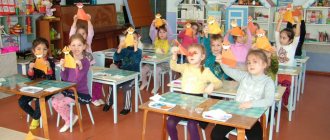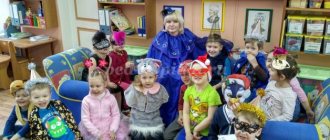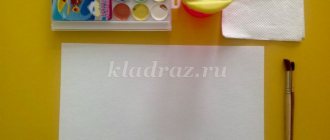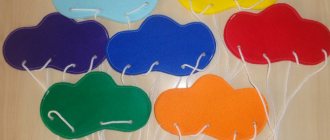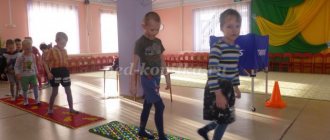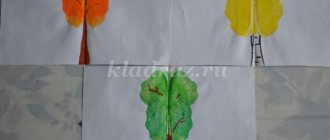Summary of an open lesson in a senior speech therapy group on the topic “Bread is the head of everything”
An open lesson in kindergarten in a senior speech therapy group on the topic “Bread is the head of everything”
Program content: - Develop basic ideas about bread and how it is grown. — To consolidate children’s knowledge about the long journey of bread from field to table. — Reinforce the idea that bread is a daily food product. — Introduce children to the variety of bakery products. — Cultivate respect for the work of adults and respect for bread. — Enrich your vocabulary. Create an emotional mood. Dictionary: Land, tractor driver, grain growers, harvesting, harvest, baker, bread, kalach, loaf, loaf, flatbread, bakery product. Preliminary work: Examination of the albums “Where did the bread come from?”;
“How our ancestors grew bread”; reading fairy tales and stories, memorizing poems, proverbs, sayings about bread, conversations about the work of grain growers. Progress of the lesson:
Organizational stage. Music is playing. Children with spikelets in their hands enter the hall and stand in a semicircle. Presenter: Hello, dear guys! Today we have a special autumn holiday. And you will find out what it is dedicated to by guessing the riddle: It can be black, white, and it is always tanned. The most delicious, incomparable, familiar to everyone from childhood. This is our ordinary and favorite Russian... Children: Bread! Presenter: That's right, guys, this is bread, and today we celebrate the Feast of Bread.
“Bread is the head of everything.” Main stage.
Children read poems about bread.
1 child: We love fragrant bread, fragrant, golden, as if bathed in the sun. It contains our health, strength. It has a wonderful warmth. How many hands raised it, protected it, took care of it! Child 2: After all, the grains did not immediately become the Bread that is on the table. People worked long and hard on the earth! Presenter: Guys! Let's think about it and name what kind of bread is it? Children: White, black, soft, fresh, aromatic, tasty, appetizing, with a golden crust. Presenter: Bread can be different, but always tasty and very healthy. (children sit on chairs to the music) Presenter: What’s a holiday without guests? Of course, it’s more fun with guests! Let's meet our dear guest - the Queen of the Fields! (The Queen of the Fields enters the hall to the song) Queen of the Fields: Hello, friends! On an autumn day, on a wonderful day, I am glad to see you. I am the Queen of the Fields, I have long dreamed of meeting you. Guys! Do you know how and what bread is made from? Children: Yes! (read poetry) 1 child: Behind the forests, behind the meadows Thunder is heard in the field These are large tractors Plowing the light black soil. 2 child: New machines have come out into the wide valleys Look through the open window - 3 child: How much work has been put into this grain Only the sun knows Wind and water 4 child: The grain growers sowed the grain in the spring It ripened and stood like a golden wall And the country hears: “It’s time for harvesting !” For bread you need combines and tractors. Presenter: And so that there is a good harvest, they read chants. 5 child: Urine, wet the rain On our rye On grandmother's wheat On grandfather's barley Water all day. Child 6: It’s raining more! I'll give you the grounds! Water a loaf of bread at least all day long! Queen of the Fields: You guys are great! And now my assistant spikelet will play a game with you. Spikelet: Where did the bread come from? (children: from the store) How did he get into the store? (from the bakery) What do they do in the bakery? (they bake bread) What is bread made from? (from flour) What does flour come from? (from grain) Where does the grain come from? (from the ear) Where does the ear come from? (grew up in a field) Who sowed wheat/rye? (collective farmer) Queen of the Fields: Well done, guys! All questions were answered. Now show me how bread grows! Physical education minute. Children stand near the chairs, pronounce words and show movements. Children: We plant a grain in the ground (pinches on the palm), The rain waters the ground (we stroke it) And the sprout grows, grows (hands up), Grows like a mushroom (house above your head) Spikelets grow (arms to the sides) Of unprecedented height (hands under the chin ). The children sit down. Queen of the Fields: Now, guys, guess my riddles. 1. The house grew up in the field The house is full of grain The walls are gilded The shutters are boarded up (Spike) 2. It stands like a wall It makes noise like a wave The golden wave The edge is not visible. (Field of rye) 3. All cast from gold Stands on a straw (Spikelet) 4. No days off from year to year The bakery works The street smells of vanilla If it bakes... (Bun) 5. White bread is oblong And airy, like cotton wool On top it’s all ribbed This is a rifled... (Loaf) Queen of the Fields: Well done, guys! All the riddles were solved. Do you know proverbs about bread? Children: Yes! 1 child: Bread is the head of everything. Child 2: Without bread, there is no lunch. Child 3: It’s not the fur coat that keeps you warm, it’s the bread. 4 child: If there is not a piece of bread, then there is sadness in the mansion. Child 5: Trampling bread underfoot means people go hungry. Queen of the Fields : Guys, I have another game for you - I know you’ll like it. Look, I have cards with pictures and 2 baskets in my hands. You need to put cards with pictures about bread and what is connected with it into baskets, and put all the other pictures on the table. Let's split into two teams. Team of girls - grains. Team of boys - spikelets. (Game with cards) Now let's look at what you put in the baskets. Well done! None of you were wrong. Presenter: Guys, who else do you think we should invite to visit? Children: Autumn! Presenter: Correct! Let's invite Autumn to visit. All: Autumn, Autumn, you are welcome! (Music sounds, Autumn appears in the hall, dancing) Autumn: Apparently I came on time. It’s not in vain that I hurried to you, friends! I love holidays very much and I always give them to people. Become, people, in a merry round dance. (Round dance with Autumn) Autumn, autumn, golden autumn Our guest, dear guest It’s good that you came, What did Autumn bring to us? Autumn: I brought you from the fields Spikelets of wheat The children will have excellent pies Children: Thank you, Autumn. Presenter: We will bake pies with different fillings. Come on, fruits, vegetables, come out and tell us everything about yourself. (Children put on hats of vegetables and fruits and read poetry) 1 child: A yellow, sweet fruit - a banana - sailed to us from distant countries. Adults and children love to treat themselves to this fruit. Child 2: A yellow-skinned lemon, it’s full of vitamins, add it to your tea, and you’ll look more cheerful! 3rd child: Grapes, grapes Many berries in a row Grew on a branch Obede, children! 4 child: A hundred clothes without fasteners. A lot of leaves, a lot of crunch. And its name is cabbage. Child 5: I’m beautiful and tasty. Well, there’s only one bone. There is a lot of pulp, amazingly. Well, of course, I am a plum. That's it: (stretching the canvas-pie, we go in a round dance) We are on holiday Together on time Prepared the pie We will invite all the guests We will treat you to the pie One, two, three - quickly run to visit (children change places, run to visit; we play several times) Queen of the Fields: Thank you, guys, for such a wonderful holiday. I collected golden wheat from my fields and baked you a ruddy white bread. Help yourself! Presenter: Guys, let's thank the Queen of the Fields! (everyone says “Thank you!” in unison) Queen of the Fields: Goodbye, guys! Be healthy! Take care of the bread. Presenter: Our holiday is coming to an end here in the hall, but will continue with tea in the group. (Children go to the group to the music)
We recommend watching:
Summary of a lesson on speech development in the senior group on the topic: Autumn GCD for the senior group with a presentation on the topic: Gifts of Autumn Summary of a lesson in the senior group on the museum program on the topic: Autumn Summary of a lesson in mathematics in the senior group for children with mental retardation. Journey to the autumn forest
Similar articles:
Lesson summary - traveling in kindergarten for the International Day for Older Persons
Entertainment “Visiting Autumn”. Senior group
“Retelling the story “Where the bread came from” - compiling a series of plot pictures”
Transcript
1 Municipal budgetary preschool educational institution of a combined type d/s 40 “Snowdrop” of a combined type Abstract of an open lesson on speech development in the senior group “Retelling the story “Where the bread came from” - drawing up a series of plot pictures” Compiled by: teacher of the 1st qualification category Sorokina Ekaterina Aleksandrovna Osinnikovsky urban district 2014 1
2 Topic: Retelling the story “Where the bread came from” - compiling a series of plot pictures. Goal: To clarify and consolidate children’s understanding of growing bread; consolidate knowledge about who grows bread, where and from what; what grains are flour made from, what types of bread are there. Learn to write a story using pictures. Foster a caring attitude towards bread, respect for the work of the people involved in its cultivation, and cultivate an environmental culture. Material: ball, Move: I. Guys, I’ll now tell you a riddle, and you try to guess it. And then you will know what I want to tell you about. He is black, he is white, and he is always tanned. Whenever we want to eat, we always sit down with him. (Bread). Today we will find out where the bread came from in the bread department of the store. II. Game “Name the profession” Who works on the tractor? Who works on the combine? Who grows the bread? Who works at the mill? Who works at the bakery? III. Children, let us imagine that we are spikelets in a field and do an exercise called “Spikelets” (an exercise to develop coordination of movements “Spikelets”) 2
3 In the spring the field was plowed. The field was sown with grain. The sun is hot. The earth is warmed. The spikelets have risen high, They are reaching for the sun. The wind blows, Koloski shakes. They bent to the right, and swung to the left. And as the rain falls, the driver drinks and drinks Rye. What a field! How beautiful she is. Children make sliding movements of their palms against each other. They touch the fingers of one hand to the palm of the other and move the hand to the side (“sow”). They cross their palms, spread their fingers, raise their hands (“sun”) Lower their hands, making springy movements with their palms open to the floor. Bend your elbows, turn your palms towards each other and slowly raise your arms. They swing their arms above their heads. Tilt the body and arms to the right and left. Slowly they lower their hands. Moving my fingers quickly. Cup your palms and bring them to your mouth (“drink”) Raise your hands, fingers spread. Shake hands above head IV. Examination of a series of paintings followed by discussion. 1. What time of year is shown in the first picture? 2. Where does the tractor work? What is the name of the profession of a person who works on a tractor? 3. What work does the tractor do? 4. What is the name of the technique in the third picture? What work does a seeder do? 5. What work does the plane do? Why do you need to fertilize the field? 6. When does wheat ripen? 7. What is used to harvest wheat? What is the name of the profession of a person who works on a combine? 8. What is bread made from? 9. What needs to be done with wheat grains to make flour? 10. Where are beeches and loaves baked? Who bakes them? 11. Where is the bread then taken? 12. How should you treat bread? 3
4 VI. Compose a story together with the teacher. Spring has come. The snow has melted. Tractor drivers went out into the field to plow and loosen the soil for future grain. The grain growers sowed grain into seeders and began to scatter it across the field. And then a plane took off into the sky to fertilize the wheat field. The fertilizer will fall into the ground, and the wheat will grow and ripen. By the end of summer, the wheat field will be in full bloom. Combine operators will go out into the field. Harvesters will float across a wheat field, as if across a blue sea. The threshed grain is ground into flour. In the bakery they will bake warm, fragrant bread from it. And they will take you to the store. VII. Game “Name it affectionately” 1. Ear 2. Loaf 3. Grain 4. Bagel 5. Bagel 6. Loaf 7. Land 8. Store, etc. VIII. Physical education lesson: The snow will melt in a clean field, the melt water will subside - it will run after the tractor driver to the blue furrow river. Then the seeders will come out to sow the fields with grain. 4
5 IX. Continuation of children's stories. X. Summary of the lesson. Where did the bread grow? What was it made from? Where bread is baked, and what professions people worked to grow bread. We learned that there is such a profession as a grain grower who grows bread. XI. Children are invited to recite poems about bread. 5
